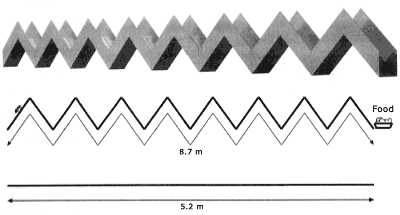Articles
Ants Find Their Way by Advanced Mathematics
by Jonathan Sarfati
The Saharan desert ant, Cataglyphis fortis, often travels hundreds of metres in zigzag paths to food, but can find its way to its nest over a different route, despite the near lack of landmarks.
There were several plausible explanations, but researchers from Germany and Switzerland1 have performed careful experiments that ruled out the use of visual clues, time or energy. For instance, the ants were tested on uniformly grey and smooth surroundings, but the ants unerringly found their way.
The evidence is consistent with ants having a built-in odometer that performs a complicated mathematical operation called path integration. That is, the journey is divided into small vectors, each with a certain length and direction, and they are added to give a ‘homing’ vector that gives the direction and total distance to the nest.
But what about bumps in the terrain, which would be like ‘hills’ and ‘valleys’ to the ant, and cause the ants to walk further than on totally flat ground? To find out, the researchers trained groups of 21 ants on trails with many symmetrical tall hills and deep valleys (to an ant’s scale) to locate a food source that would take them 8.7 m to walk, but which was only 5.2 m of ground (horizontal) distance away. Then they transformed the intervening terrain to a flat surface. The ants then walked a far shorter distance which was very close to the ground distance.
And vice versa, when 17 ants were trained on flat terrain to find a food source 5.2 m away, and the terrain then transformed into hills and valleys, the ants walked a distance very close to the distance (8.7 m) that equates to the ground distance.
The experimenters ruled out the possibility that the ants were using only the uphill (or only the downhill) paths by performing similar tests on asymmetric hills.

A U-shaped channel arranged in a saw-tooth pattern (top) was the basis for this experiment. Ants were trained to forage over this simulated ‘hilly’ terrain to a food source located at the end (middle). When put on simulated flat terrain, the ants walked a shorter distance equivalent to that of the projection of the ‘hilly’ terrain onto a fictitious horizontal plane before hunting for food (bottom). |
This means that the ants apparently calculate the horizontal projection of the distance travelled. That is, the image of the ant’s travel vectors is projected onto an imaginary flat screen underneath the ant’s terrain, and the path integration is performed in this x-y plane. To do this, the ants must have a way of estimating the slopes, and multiplying the travelled distance by the cosine of the angle of inclination to work out the corresponding ground distance.
The ants probably use the internal sense called proprioception, which animals and humans use to determine the location of their body parts. Ants probably measure slopes by the same means as they sense gravity, i.e. by proprioceptors on various joints between moving parts. These are a number of hairplates, and there may be some backup design so one might take over another’s function if it is surgically removed. This makes it hard to determine the exact mechanisms involved in precisely determining ground distance.
The alternative mechanism to horizontal projection is the even more elaborate three-dimensional path integration, which the researchers plan to investigate. One way suggested would be by training ants to find food at the end of a ramp, then testing them on terrain with a totally vertical channel, where the horizontal projection is zero, at the end of a completely horizontal channel. If horizontal projection is correct, then they would ignore the vertical channel and search at the end of the horizontal channel corresponding to the ground distance. Only if they are performing 3D integration should they climb up the vertical channel to search for their food.2
Implications

If ants trained to find food at the end of a ramp (a) also hunted for food at the top rather than the base of an L-shaped section (b) this would show that ants integrate in three dimensions rather than just projecting their position onto a horizontal plane. |
Whether the ants are using horizontal path integration or a fully 3D integration, this still involves advanced programming. It’s common sense to believe that a program requires a programmer. However, the religious belief in the sufficiency of naturalistic causes means that evolutionists will reject this common sense view. They might claim that a homing sense could evolve by random mutations causing better and better improvements, which natural selection would accumulate.
But the fallacy in this is assuming that a small change in a program has small changes in effect. Human programmers know that a single step in an algorithm often has far-reaching consequences, and one wrong step can often cause the program to crash. Rather, the path integration program must be fully functional or else it is likely to be totally useless.
References
- Wohlgemuth, S., Ronacher, B. and Wehner, R., Ant odometry in the third dimension, Nature 411(6839):795–798, 2001.
- Srinivasan, M.V., Homing in on ant navigation [comment on Ref. 1], Nature 411(6839): 752–753, 2001.
http://www.answersingenesis.org/tj/v15/i2/ants.asp
|

